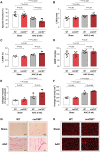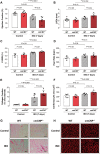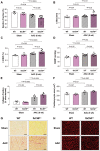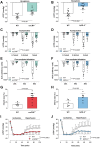C-type natriuretic peptide co-ordinates cardiac structure and function
- PMID: 30903134
- PMCID: PMC7068173
- DOI: 10.1093/eurheartj/ehz093
C-type natriuretic peptide co-ordinates cardiac structure and function
Abstract
Aims: C-type natriuretic peptide (CNP) is an essential endothelium-derived signalling species that governs vascular homoeostasis; CNP is also expressed in the heart but an intrinsic role for the peptide in cardiac function is not established. Herein, we employ unique transgenic strains with cell-specific deletion of CNP to define a central (patho)physiological capacity of CNP in maintaining heart morphology and contractility.
Methods and results: Cardiac structure and function were explored in wild type (WT), cardiomyocyte (cmCNP-/-), endothelium (ecCNP-/-), and fibroblast (fbCNP-/-)-specific CNP knockout mice, and global natriuretic peptide receptor (NPR)-B-/-, and NPR-C-/- animals at baseline and in experimental models of myocardial infarction and heart failure (HF). Endothelium-specific deletion of CNP resulted in impaired coronary responsiveness to endothelium-dependent- and flow-mediated-dilatation; changes mirrored in NPR-C-/- mice. Ex vivo, global ischaemia resulted in larger infarcts and diminished functional recovery in cmCNP-/- and NPR-C-/-, but not ecCNP-/-, vs. WT. The cardiac phenotype of cmCNP-/-, fbCNP-/-, and NPR-C-/- (but not ecCNP-/- or NPR-B-/-) mice was more severe in pressure overload- and sympathetic hyperactivation-induced HF compared with WT; these adverse effects were rescued by pharmacological CNP administration in WT, but not NPR-C-/-, mice. At a molecular level, CNP/NPR-C signalling is impaired in human HF but attenuates activation of well-validated pro-hypertrophic and pro-fibrotic pathways.
Conclusion: C-type natriuretic peptide of cardiomyocyte, endothelial and fibroblast origins co-ordinates and preserves cardiac structure, function, and coronary vasoreactivity via activation of NPR-C. Targeting NPR-C may prove an innovative approach to treating HF and ischaemic cardiovascular disorders.
Keywords: Heart failure; Cardiomyocyte; Endothelium; Ischaemia/reperfusion injury; Natriuretic peptide; Natriuretic peptide receptor.
© The Author(s) 2019. Published by Oxford University Press on behalf of the European Society of Cardiology.
Figures










Comment in
-
C-type natriuretic peptide: the heart's guardian angel.Eur Heart J. 2020 Mar 1;41(9):1021-1023. doi: 10.1093/eurheartj/ehz142. Eur Heart J. 2020. PMID: 30907411 Free PMC article. No abstract available.
References
-
- Moyes AJ, Khambata RS, Villar I, Bubb KJ, Baliga RS, Lumsden NG, Xiao F, Gane PJ, Rebstock AS, Worthington RJ, Simone MI, Mota F, Rivilla F, Vallejo S, Peiro C, Sanchez Ferrer CF, Djordjevic S, Caulfield MJ, MacAllister RJ, Selwood DL, Ahluwalia A, Hobbs AJ.. Endothelial C-type natriuretic peptide maintains vascular homeostasis. J Clin Invest 2014;124:4039–4051. - PMC - PubMed
-
- Nakao K, Kuwahara K, Nishikimi T, Nakagawa Y, Kinoshita H, Minami T, Kuwabara Y, Yamada C, Yamada Y, Tokudome T, Nagai-Okatani C, Minamino N, Nakao YM, Yasuno S, Ueshima K, Sone M, Kimura T, Kangawa K, Nakao K.. Endothelium-derived C-type natriuretic peptide contributes to blood pressure regulation by maintaining endothelial integrity. Hypertension 2017;69:286–296. - PubMed
-
- Spiranec K, Chen W, Werner F, Nikolaev VO, Naruke T, Koch F, Werner A, Eder-Negrin P, Dieguez-Hurtado R, Adams RH, Baba HA, Schmidt H, Schuh K, Skryabin BV, Movahedi K, Schweda F, Kuhn M.. Endothelial C-type natriuretic peptide acts on pericytes to regulate microcirculatory flow and blood pressure. Circulation 2018;138:494–508. - PubMed
-
- Vollmar AM, Gerbes AL, Nemer M, Schulz R.. Detection of C-type natriuretic peptide (CNP) transcript in the rat heart and immune organs. Endocrinology 1993;132:1872–1874. - PubMed
-
- Del Ry S, Cabiati M, Vozzi F, Battolla B, Caselli C, Forini F, Segnani C, Prescimone T, Giannessi D, Mattii L.. Expression of C-type natriuretic peptide and its receptor NPR-B in cardiomyocytes. Peptides 2011;32:1713–1718. - PubMed
Publication types
MeSH terms
Substances
Grants and funding
LinkOut - more resources
Full Text Sources
Medical
Molecular Biology Databases
Research Materials
Miscellaneous

